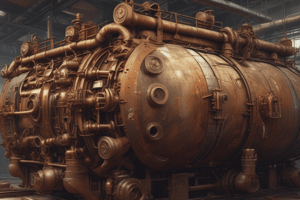Podcast
Questions and Answers
What is the definition of corrosion?
What is the definition of corrosion?
- The gradual destruction or deterioration of metals or alloys by the chemical or electrochemical reaction with its environment. (correct)
- The extraction of metals from their ores.
- The formation of stable compounds from metals and alloys.
- The rapid destruction of metals or alloys by the chemical or electrochemical reaction with its environment.
Which of the following metals exists in the native state and has good corrosion resistance?
Which of the following metals exists in the native state and has good corrosion resistance?
- Iron
- Lead
- Copper
- Gold (correct)
What is the reason why metals are unstable in their pure metallic state?
What is the reason why metals are unstable in their pure metallic state?
- They are non-reactive with the environment.
- They are reactive with the environment.
- They are in a lower energy state.
- They are in a higher energy state. (correct)
What happens to the metals after they are extracted from their ores?
What happens to the metals after they are extracted from their ores?
What is the driving force behind the corrosion of metals?
What is the driving force behind the corrosion of metals?
What is the primary reason for metallic corrosion?
What is the primary reason for metallic corrosion?
What happens to the efficiency of a machine due to corrosion?
What happens to the efficiency of a machine due to corrosion?
What is a consequence of corrosion on the value of goods?
What is a consequence of corrosion on the value of goods?
What is a common example of corrosion?
What is a common example of corrosion?
What can be a health hazard due to corrosion?
What can be a health hazard due to corrosion?
Flashcards are hidden until you start studying
Study Notes
Metal Corrosion and Its Prevention
- Metals and alloys are used as fabrication or construction materials in engineering, but they can deteriorate slowly by the action of atmospheric gases, moisture, and other chemicals if not properly maintained.
- Corrosion is defined as the gradual destruction or deterioration of metals or alloys by chemical or electrochemical reaction with their environment.
Origin of Corrosion
- Metals occur in nature in two different forms: native state and combined state.
- Native metals are non-reactive with the environment, have good corrosion resistance, and are typically noble metals like Au, Pt, and Ag.
- Combined metals are reactive, react with the environment, and form stable compounds like oxides, sulphides, chlorides, and carbonates, and exist in their form of stable compounds called ores and minerals (e.g., Fe2O3, ZnO, PbS, CaCO3).
Causes and Consequences of Corrosion
- Metals are extracted from ores and are reduced to their metallic states, but in the pure metallic state, they are unstable and have higher energy.
- As soon as metals are extracted from their ores, the reverse process begins, and they form metal compounds that are thermodynamically stable, with lower energy.
- When metals are used in various forms, they are exposed to the environment, and the exposed metal surface begins to decay, converting into more stable compounds.
- Corrosion leads to the loss of useful properties like electrical conductivity, ductility, and malleability.
- Consequences of corrosion include:
- Loss of efficiency in machinery
- Contamination of products
- Frequent replacement of corroded equipment
- Plant failure
- Need for over design to compensate for corrosion
- Release of toxic products, health hazards, and more
- Loss of time and value of goods
Studying That Suits You
Use AI to generate personalized quizzes and flashcards to suit your learning preferences.




